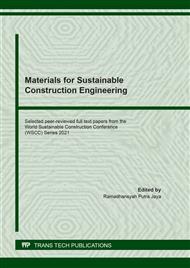[1]
Abayomi, M. E., Olumoyewa, A. D., Adebayo, B. O., Gana, A. J., John, R. A. L., & Raphael, O. D. (2019). Development and performance evaluation of crumb rubber – Bio-oil modified hot mix asphalt for sustainable highway pavements. International Journal of Mechanical Engineering and Technology, 10(2), 273–287.
Google Scholar
[2]
Bruinsma, J., Smith, K., Peshkin, D., Ballou, L., Eisenberg, B., Lurie, C., Costa, M., Ung, C., Nassiri, S., Shi, X., Haselbach, L. (2017). Guidance for Usage of Permeable Pavement at Airports. Guidance for Usage of Permeable Pavement at Airports. Transportation Research Board. https://doi.org/10.17226/24852.
DOI: 10.17226/24852
Google Scholar
[3]
Litman, T. (2021). Evaluating Public Transit Benefits and Costs. Victoria Transport Policy Institute, 1–143. Retrieved from http://www.vtpi.org/tranben.pdf.
Google Scholar
[4]
Elliott, R., Fergusson, C., Richardson, J., Stevenson, A., & James, D. (2014). Long life surfaces for busy roads. In Asphalt Pavements - Proceedings of the International Conference on Asphalt Pavements, ISAP 2014 (Vol. 1, p.211–220). Taylor and Francis - Balkema. https://doi.org/10.1201/b17219-34.
DOI: 10.1201/b17219-34
Google Scholar
[5]
Mashaan, N., Karim, M., Khodary, F., Saboo, N., & Milad, A. (2021). Bituminous Pavement Reinforcement with Fiber: A Review. CivilEng, 2(3), 599–611. https://doi.org/10.3390/civileng2030033.
DOI: 10.3390/civileng2030033
Google Scholar
[6]
Wagaw, F., Emer, P., Quezon, T., & Geremew, A. (2018). Evaluation of the Performance of Brick Dust as a Filler Material for Hot Asphalt Mix Design : A Case Study in Jimma Zone. The International Journal of Engineering and Science (IJES), 7(3), 64–72.
Google Scholar
[7]
Salim, R. (2019). Asphalt Binder Parameters and their Relationship to the Linear Viscoelastic and Failure Properties of Asphalt Mixtures. Journal of Chemical Information and Modeling, 53(9), 1689–1699.
Google Scholar
[8]
Honarmand, M., Tanzadeh, J., & Beiranvand, M. (2019). Bitumen and Its Modifier for Use in Pavement Engineering. In Sustainable Construction and Building Materials. IntechOpen. https://doi.org/10.5772/intechopen.82489.
DOI: 10.5772/intechopen.82489
Google Scholar
[9]
Colonna, P., Berloco, N., Ranieri, V., & Shuler, S. T. (2012). Application of Bottom Ash for Pavement Binder Course. Procedia - Social and Behavioral Sciences, 53, 961–971. https://doi.org/10.1016/j.sbspro.2012.09.945.
DOI: 10.1016/j.sbspro.2012.09.945
Google Scholar
[10]
Ameli, A., Babagoli, R., Norouzi, N., Jalali, F., & Poorheydari Mamaghani, F. (2020). Laboratory evaluation of the effect of coal waste ash (CWA) and rice husk ash (RHA) on performance of asphalt mastics and Stone matrix asphalt (SMA) mixture. Construction and Building Materials, 236. https://doi.org/10.1016/j.conbuildmat.2019.117557.
DOI: 10.1016/j.conbuildmat.2019.117557
Google Scholar
[11]
Xu, P., Chen, Z., Cai, J., Pei, J., Gao, J., Zhang, J., & Zhang, J. (2019). The effect of retreated coal wastes as filler on the performance of asphalt mastics and mixtures. Construction and Building Materials, 203, 9–17. https://doi.org/10.1016/j.conbuildmat.2019.01.088.
DOI: 10.1016/j.conbuildmat.2019.01.088
Google Scholar
[12]
Ravindra Tomar, R. K. J. and M. K. K. (2013). Effect of Fillers On Bituminous Paving Mixes. International Journal of Engineering and Research and Science & Technology, 2(December 2014), 5–7.
Google Scholar
[13]
ASTM. (2008). JKR/SPJ/2008-S4 Standard Specification for Road Works Part4 Flexible Pavement. JKR Specification for Road Works Part4 Flexible Pavement, 07(Reapproved), 1–187.
Google Scholar
[14]
BS EN 1097-2:2010. (2010). Tests for mechanical and physical properties of aggregates. Part 2: Methods for the determination of resistance to fragmentation. British Standard, 34p.
Google Scholar
[15]
BS EN 1426, 2015, Bitumen and bituminous binders — Determination of needle penetration,, British Standards Institution: London, United Kingdom.
Google Scholar
[16]
BS EN 1427, 2015, Bitumen and bituminous binders — Determination of the softening point — Ring and Ball method,. British Standards Institution: London, United Kingdom.
DOI: 10.3403/30255301
Google Scholar
[17]
ASTM D6931-12. (2017). Standard Test Method for Indirect Tensile ( IDT ) Strength of Asphalt Mixtures. American Society for Testing and Materials International, West Conshohocken, PA, 1–5.
Google Scholar
[18]
ASTM D7369. (2020). Standard Test Method for Determining the Resilient Modulus of Asphalt Mixtures by Indirect Tension Test. ASTM International, (pp.1-4). West Conshohocken.
DOI: 10.1520/d7369-11
Google Scholar
[19]
BS EN 12697-25. (2016). Bituminous Mixtures, Test Methods. British Standards Institution, London: Cyclic Compression Test.
Google Scholar
[20]
Song, S., & Yeom, C. (2021). Reduction of plastic deformation in heavy traffic intersections in urban areas. Sustainability (Switzerland), 13(7). https://doi.org/10.3390/su13074002.
DOI: 10.3390/su13074002
Google Scholar
[21]
Notani, M. A., Hajikarimi, P., Nejad, F. M., & Khodaii, A. (2020). Rutting resistance of toner-modified asphalt binder and mixture. International Journal of Pavement Research and Technology, 13(1). https://doi.org/10.1007/s42947-019-0131-z.
DOI: 10.1007/s42947-019-0131-z
Google Scholar
[22]
Mugume, R. B. (2020). Effect of unstable mix under severe traffic loading on performance of asphalt pavements in tropical climate. Advances in Civil Engineering, 2020. https://doi.org/10.1155/2020/8871094.
DOI: 10.1155/2020/8871094
Google Scholar
[23]
Takaikaew, T., Hoy, M., Horpibulsuk, S., Arulrajah, A., Mohammadinia, A., & Horpibulsuk, J. (2021). Performance improvement of asphalt concretes using fiber reinforcement. Heliyon, 7(5). https://doi.org/10.1016/j.heliyon.2021.e07015.
DOI: 10.1016/j.heliyon.2021.e07015
Google Scholar
[24]
Dias, A., Silva, H., Palha, C., & Oliveira, J. (2021). Low-temperature performance of polymer-modified binders in stone mastic asphalts. Infrastructures, 6(4). https://doi.org/10.3390/INFRASTRUCTURES6040058.
DOI: 10.3390/infrastructures6040058
Google Scholar


